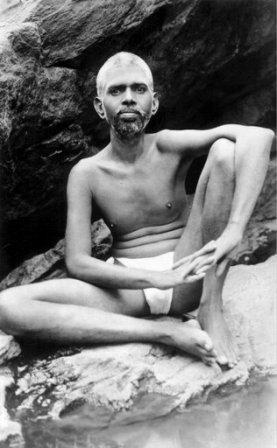
|
|
Spiritual
Instructions by Ramana Maharshi
Question
1: What are the marks of a real teacher (Sadguru)?
Ramana Maharshi:
Steady abidance in the Self, looking at all with
an equal eye, unshakeable courage at all times, in all places
and circumstances, etc.
Question 2: What are the marks of
an earnest disciple (sadsisya)?
Ramana Maharshi:
An intense longing for the removal of sorrow and
attainment of joy and an intense aversion for all kinds of
mundane pleasure.
Question 3:
What are the characteristics of instruction (upadesa)?
Ramana Maharshi:
The word ‘upadesa’ means : ‘near the place or
seat’ (upa - near, desa - place or seat). The Guru who is the
embodiment of that which is indicated by the terms sat, chit,
and ananda (existence, consciousness and bliss), prevents the
disciple who, on account of his acceptance of the forms of the
objects of the senses, has swerved from his true state and is
consequently distressed and buffeted by joys and sorrows, from
continuing so and establishes him in his own real nature without
differentiation.
Upadesa also means showing a distant object quite near. It is
brought home to the disciple that the Brahman which he believes
to be distant and different from himself is near and not
different from himself.
Question 4: If it be true that the
Guru is one’s own Self (atman), what is the principle underlying
the doctrine which says that, however learned a disciple may be
or whatever occult powers he may possess, he cannot attain
self-realization (atma-siddhi) without the grace of the Guru?
Ramana Maharshi:
Although in absolute truth the state of the Guru
is that of oneself it is very hard for the Self which has become
the individual soul (jiva) through ignorance to realize its true
state or nature without the grace of the Guru.
All mental concepts are controlled by the mere presence of the
real Guru. If he were to say to one who arrogantly claims that
he has seen the further shore of the ocean of learning or one
who claims arrogantly that he can perform deeds which are
well-nigh impossible, “Yes, you learnt all that is to be learnt,
but have you learnt (to know) yourself? And you who are capable
of performing deeds which are almost impossible, have you seen
yourself?”, they will bow their heads (in shame) and remain
silent. Thus it is evident that only by the grace of the Guru
and by no other accomplishment is it possible to know oneself.
Question 5: What are the marks of
the Guru’s grace?
Ramana Maharshi:
It is beyond words or thoughts.
Question 6: If that is so, how is
it that it is said that the disciple realizes his true state by
the Guru’s grace?
Ramana Maharshi:
It is like the elephant which wakes up on seeing a
lion in its dream. Even as the elephant wakes up at the mere
sight of the lion, so too is it certain that the disciple wakes
up from the sleep of ignorance into the wakefulness of true
knowledge through the Guru’s benevolent look of grace.
Question 7: What is the
significance of the saying that the nature of the real Guru is
that of the Supreme Lord (Sarvesvara)?
Ramana Maharshi:
In the case of the individual soul which desires
to attain the state of true knowledge or the state of Godhood (Isvara)
and with that object always practises devotion, when the
individual’s devotion has reached a mature stage, the Lord who
is the witness of that individual soul and identical with it,
comes forth in human form with the help of sat-chit-ananda, His
three natural features, and form and name which he also
graciously assumes, and in the guise of blessing the disciple,
absorbs him in Himself. According to this doctrine the Guru can
truly be called the Lord.
Question 6: How then did some great
persons attain knowledge without a Guru?
Ramana Maharshi:
To a few mature persons the Lord shines as the
light of knowledge and imparts awareness of the truth.
Source: From the book “Spiritual Instruction” by Ramana Maharshi
^Top
Back to Masters
|
|
